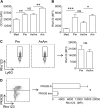Leishmania amazonensis amastigotes trigger neutrophil activation but resist neutrophil microbicidal mechanisms
- PMID: 23918780
- PMCID: PMC3811833
- DOI: 10.1128/IAI.00770-13
Leishmania amazonensis amastigotes trigger neutrophil activation but resist neutrophil microbicidal mechanisms
Abstract
Neutrophils are the first cells to infiltrate to the site of Leishmania promastigote infection, and these cells help to reduce parasite burden shortly after infection is initiated. Several clinical reports indicate that neutrophil recruitment is sustained over the course of leishmaniasis, and amastigote-laden neutrophils have been isolated from chronically infected patients and experimentally infected animals. The goal of this study was to compare how thioglycolate-elicited murine neutrophils respond to L. amazonensis metacyclic promastigotes and amastigotes derived from axenic cultures or from the lesions of infected mice. Neutrophils efficiently internalized both amastigote and promastigote forms of the parasite, and phagocytosis was enhanced in lipopolysaccharide (LPS)-activated neutrophils or when parasites were opsonized in serum from infected mice. Parasite uptake resulted in neutrophil activation, oxidative burst, and accelerated neutrophil death. While promastigotes triggered the release of tumor necrosis factor alpha (TNF-α), uptake of amastigotes preferentially resulted in the secretion of interleukin-10 (IL-10) from neutrophils. Finally, the majority of promastigotes were killed by neutrophils, while axenic culture- and lesion-derived amastigotes were highly resistant to neutrophil microbicidal mechanisms. This study indicates that neutrophils exhibit distinct responses to promastigote and amastigote infection. Our findings have important implications for determining the impact of sustained neutrophil recruitment and amastigote-neutrophil interactions during the late phase of cutaneous leishmaniasis.
Figures






References
-
- Sacks D, Noben-Trauth N. 2002. The immunology of susceptibility and resistance to Leishmania major in mice. Nat. Rev. Immunol. 2:845–858 - PubMed
-
- Osorio y Fortea J, Prina E, de La Llave E, Lecoeur H, Lang T, Milon G. 2007. Unveiling pathways used by Leishmania amazonensis amastigotes to subvert macrophage function. Immunol. Rev. 219:66–74 - PubMed
-
- Mougneau E, Bihl F, Glaichenhaus N. 2011. Cell biology and immunology of Leishmania. Immunol. Rev. 240:286–296 - PubMed
Publication types
MeSH terms
Substances
Grants and funding
LinkOut - more resources
Full Text Sources
Other Literature Sources
Molecular Biology Databases

